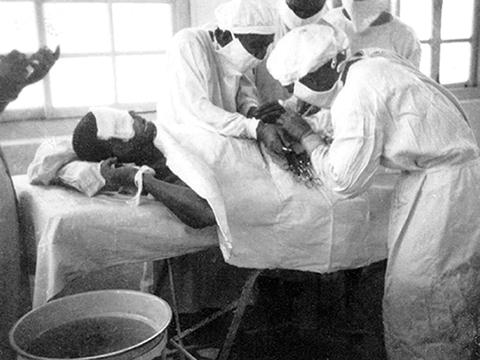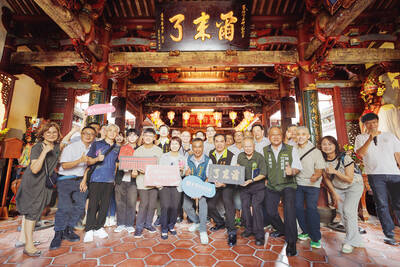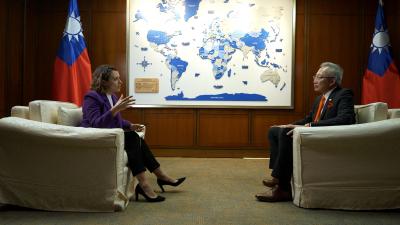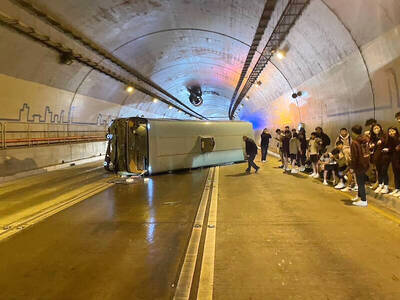They might be unforgivable, vicious insurrectionists in the eyes of dictator Chiang Kai-shek (蔣介石), but the political prisoners on Green Island played a pivotal role in the local economic, agricultural, medical, educational and cultural development.
The premiere of director Hung Lung-pang’s (洪隆邦) documentary film, One Day on Green Island (綠島的一天), at a human rights memorial last Friday offered a rare insight into the close friendship that developed between the island’s residents and the prisoners.
Political prisoner Ouyang Wen (歐陽文) said: “We saw topless women when we went ashore, so we thought they were Aborigines.”

PHOTO TAKEN BY FORMER PRISONER CHEN MENG-HE
The women turned out to be emigrants from Little Liuchiu in Pingtung County and China’s Fujian Province who were too poor to buy clothes. They could only take the red clothes offered by fishermen at the Guanyi Temple after a big haul of fish and with the god’s permission through divination blocks to cover the lower part of their bodies.
The prison had no walls when the first batch of political prisoners arrived on the island on May 17, 1951.
The officials told the local residents: “You would be colluding with communists if you talk to the prisoners.”
Later, the prisoners collected stones from the sea and built walls to block themselves in.
Because of the strong sea wind and heavy fog, the island’s residents could grow nothing but peanuts and yams.
After eating moldy food shipped from Taiwan for more than a year, the officials could not take it anymore. They ordered prisoners who had doctorates in agriculture to form a team and take charge of growing tomatoes, pumpkins, water spinach and other vegetables, while raising turkeys, pigs and sheep at the same time.
They also exchanged vegetables with fish from the local fishermen.
The “Green Island” soybean sauce that the island continues to sell to this day was originally produced by then-prisoner Huang Chung-hua (黃仲華).
Former prisoner Mao Fu-cheng (毛扶正) said that their farming tools, such as sickles and hoes, were all made of melted scrap iron taken from the demolished US passenger liner SS President Hoover ran aground in 1937.
The number of prisoners on Green Island was once as high as 2,000, accounting for two-thirds of the island’s total population. More than a dozen were doctors from National Taiwan University Hospital, who asked their families to send equipment and medicine and set up a temporary clinic to treat other prisoners, officials and local residents.
Tien Fen-lai (田份來), a local resident, recalled a woman suffering from difficult labor, with the baby dying in her womb. With the help of the prisoner-doctors, they were able to take out the baby and save the woman’s life.
“Many of the prisoners were talented,” said Lin Deng-jung (林登榮), a retired teacher from Green Island Elementary School.
He said that officials once assigned a dozen of the prisoners to teach different subjects at a local elementary school. This boosted the enrolment rate, with 19 of the 20-plus students successfully entering junior high schools in Taiwan. One of the tutors at that time was the famed writer Bo Yang (柏楊).
Some of the prisoners were good at Beijing or Taiwanese opera and Chinese stand-up comedy. They often performed in the local villages.
Chen Meng-he (陳孟和), an art major from National Taiwan Normal University, used native materials that he could find on the island to manufacture violins and guitars, which have been preserved to this day.
Chen was also ordered to take photographs for the prisoners, and family pictures for the local residents at the prison’s co-op. Today, the old photos have become rare and precious historical materials.
“The political prisoners’ youth was all wasted in Green Island,” the director said, “but they changed the local residents’ destiny.”

The Central Weather Administration (CWA) today issued a "tsunami watch" alert after a magnitude 8.7 earthquake struck off the Kamchatka Peninsula in northeastern Russia earlier in the morning. The quake struck off the east coast of the Kamchatka Peninsula at 7:25am (Taiwan time) at a depth of about 19km, the CWA said, citing figures from the Pacific Tsunami Warning Center. The CWA's Seismological Center said preliminary assessments indicate that a tsunami could reach Taiwan's coastal areas by 1:18pm today. The CWA urged residents along the coast to stay alert and take necessary precautions as waves as high as 1m could hit the southeastern

The National Museum of Taiwan Literature is next month to hold an exhibition in Osaka, Japan, showcasing the rich and unique history of Taiwanese folklore and literature. The exhibition, which is to run from Aug. 10 to Aug. 20 at the city’s Central Public Hall, is part of the “We Taiwan” at Expo 2025 series, highlighting Taiwan’s cultural ties with the international community, National Museum of Taiwan Literature director Chen Ying-fang (陳瑩芳) said. Folklore and literature, among Taiwan’s richest cultural heritages, naturally deserve a central place in the global dialogue, Chen said. Taiwan’s folklore would be immediately apparent at the entrance of the

“China is preparing to invade Taiwan,” Deputy Minister of Foreign Affairs Francois Wu (吳志中) said in an exclusive interview with British media channel Sky News for a special report titled, “Is Taiwan ready for a Chinese invasion?” the Ministry of Foreign Affairs said today in a statement. The 25-minute-long special report by Helen Ann-Smith released yesterday saw Sky News travel to Penghu, Taoyuan and Taipei to discuss the possibility of a Chinese invasion and how Taiwan is preparing for an attack. The film observed emergency response drills, interviewed baseball fans at the Taipei Dome on their views of US President

Speeding and badly maintained roads were the main causes of a school bus accident on a rainy day in Taipei last year that severely injured two people and left 22 with minor injuries, the Taiwan Transportation and Safety Board said. On March 11 last year, a Kang Chiao International School bus overturned inside the Wenshan Tunnel (文山隧道) on the northbound lane of the Xinyi Expressway. The tour bus, owned by Long Lai Co, exceeded the speed limit after entering the tunnel, the board’s investigation found. Sensing that the rear of the vehicle was swaying, the driver attempted to use the service and exhaust